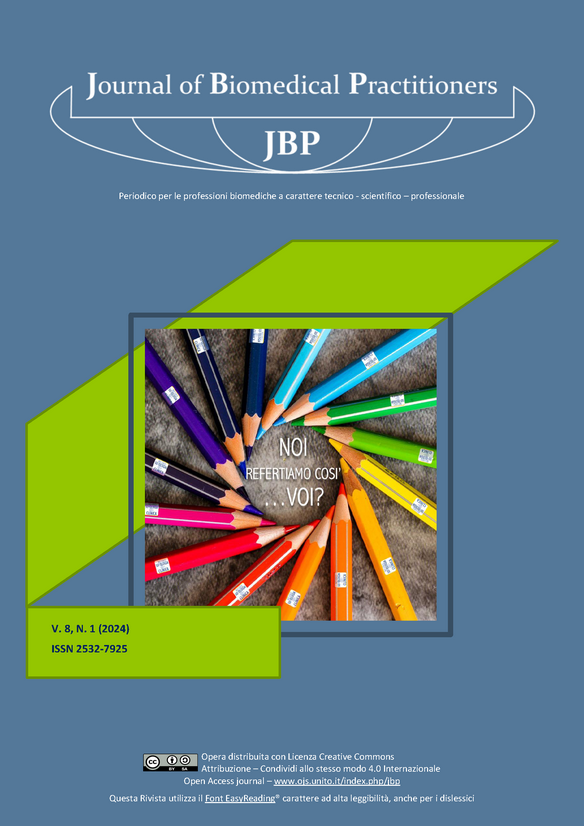Ulnar Goniometer Device: Comparison between electro-neurography and ultrasound.
Contenuto principale dell'articolo
Abstract
OBJECTIVE
Our study aims to extend the previous research and compare two diagnostic methods performed on the ulnar nerve to validate the use of the ulnar goniometer in electromyographic diagnostic practice. Comparing the electroneurographic method, obtained through conduction velocity (CV) studies with ultrasound of the ulnar nerve in the area above the elbow and at the wrist, we aim to quantify the reliability of the ulnar goniometer compared to the diagnostic method ultrasound of the nerve.
MATERIALS AND METHODS
The operator examined with the use of the Ulnar Goniometer, detecting the wrist-below-elbow motor conduction speed and the above-elbow speed (AE), below-elbow speed (BE) and subsequently performed an ultrasound examination of the ulnar nerve in the forearm and elbow. We calculated the degree of homogeneity between measurements.
RESULTS
Evaluating 30 participants of both genders with typical paresthetic symptoms of ulnar nerve compression at the elbow, 100% of the measurements show that a decrease in Motor Conduction Velocity (MCV) below 50 m/s is associated with an increase in Cross-Sectional Area (CSA). Additionally, in 89% of cases, a reduction in MCV wBE and BEAE by more than 10 m/s is correlated with an increase in CSA.
DISCUSSION AND CONCLUSIONS
The measurement of the angle below the elbow (BE) and above the elbow (AE) using the Ulnar Goniometer provides us with a slowed Motor Conduction Velocity (MCV) that is by ultrasound data showing an increase in the Cross-Sectional Area (CSA) of the ulnar nerve in that segment, as observed in Cubital Tunnel Syndrome (CTS).
Downloads
Dettagli dell'articolo
Gli autori mantengono i diritti sulla loro opera e cedono alla rivista il diritto di prima pubblicazione dell'opera, contemporaneamente licenziata sotto una Licenza Creative Commons - Attribuzione che permette ad altri di condividere l'opera indicando la paternità intellettuale e la prima pubblicazione su questa rivista.
Riferimenti bibliografici
[2] Granger A, Sardi JP, Iwanaga J, et al. (2017) Osborne’s Ligament: A Review of its History, Anatomy, and Surgi-cal Importance. Cureus. 9(3): e1080
[3] Raeissadat SA, Youseffam P, Bagherzadeh L, et al. (2019). Electrodiagnostic Findings in 441 Patients with Ulnar Neuropathy - a Retrospective Study. Orthopedic Research and Reviews. 11;191—198
[4] Raeissadat SA, Youseffam P, Bagherzadeh L, et al. (2019). Electrodiagnostic Findings in 441 Patients with Ulnar Neuropathy - a Retrospective Study. Orthopedic Research and Reviews. 11;191—198
[5] Gallicchio L, Recchia VR, Didonna L, Vecchio E, Guida P, Petruzzellis A and Tamma F,(2022) Ulnar Goniometer: a simple device for a better neurophysiological evaluation of the motor conduction velocity of the ulnar nerve. Journal of Biomedical Practitioners, 6(1), https://doi.org/10.13135/2532-7925/6844
[6] Ufficio italiano Brevetti e Marchi. Disponibile su www. uibm.mise.gov.it (patent number IT201900009912 (A1) - 2020-12 -26)
[7] Ehler E, Ridzoň P, Urban P, Mazanec R, et al. (2013). Ulnar nerve at the Elbow-normative nerve conduction stud-ies. J Brachial Plex Peripher Nerve Inj. 8:2.
[8] Ubiali E. Elettroneurografia. Testo atlante. Scienza Medica editore. 2016; 230-35
[9] Landau M, Diaz M.I, Barner K.C, Campbell K.C. (2002). Changes in nerve conduction velocity across the elbow due to experimental error. Muscle Nerve. 26(6):838-40
[10] Mezian K, Jačisko J, Kaiser R, Machač S, Steyerová P, Sobotová K, Angerová Y, Naňka O. Ulnar Neuropathy at the Elbow: From Ultrasound Scanning to Treatment. Front Neurol. 2021 May 14; 12:661441. doi: 10.3389/fneur.2021.661441. PMID: 34054704; PMCID: PMC8160369.

